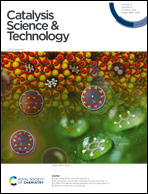Selective regulation of n-dodecane isomerization and cracking performance in Pt/beta catalysts via orientation control of Brønsted acid site distribution†
Abstract
The location of Brønsted acid sites in zeolites has been recognized as an important factor in acid-catalyzed reactions. In this work, two beta zeolites with different Brønsted acid site distributions are successfully synthesized by tuning the charge balance between the (Si–O–Al)− and TEA+ (Na+). There is no considerable change in crystallinity, textural properties, morphology and framework silicon/aluminum ratio. However, 27Al 2D 3Q MAS NMR experiments and infrared measurements (Py-IR and Me3Py-IR) reveal the different distributions of framework aluminum and Brønsted acid sites, respectively. For the conversion of n-dodecane, the location of Brønsted acid sites imposes a significant impact on the selectivity towards the skeletal rearrangement and β-scission of carbenium ions. The catalyst Pt/beta with a larger concentration of Brønsted acid sites in the 0.66 × 0.67 nm channels demonstrates lower catalytic activity but higher isomerization selectivity. However, the Pt/beta-N catalyst with more Brønsted acid sites in the 0.56 × 0.56 nm channels exhibits higher catalytic activity and higher cracking selectivity.



 Please wait while we load your content...
Please wait while we load your content...